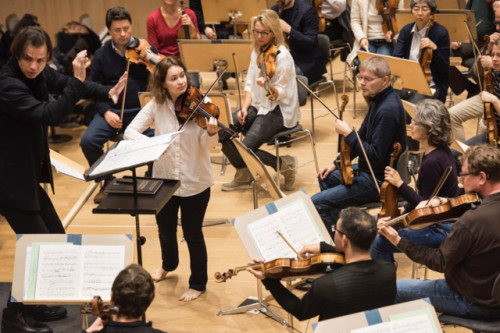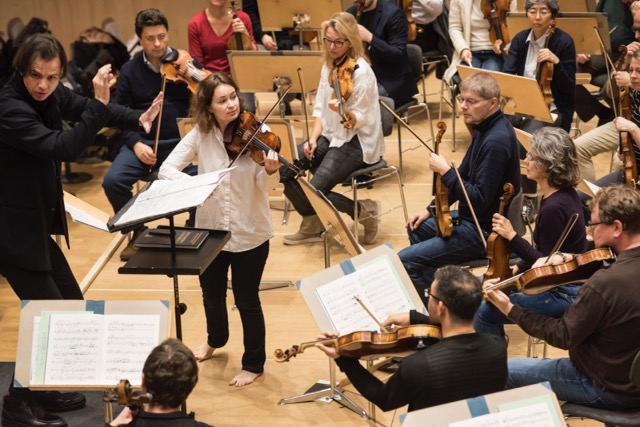 Switzerland Berg and Shostakovich: Patricia Kopatchinskaya (violin), Tonhalle Orchestra Zurich / Teodor Currentzis (conductor), Tonhalle Maag, Zurich, 30.11.2017. (JR)
Switzerland Berg and Shostakovich: Patricia Kopatchinskaya (violin), Tonhalle Orchestra Zurich / Teodor Currentzis (conductor), Tonhalle Maag, Zurich, 30.11.2017. (JR)

(c) Priska Ketterer
Berg – Violin Concerto
Shostakovich – Symphony No.5
Berg’s Violin Concerto cannot, by any stretch of the imagination, be categorised as ‘easy listening’. Some are enthralled by it, considering it a masterpiece of its age, others are simply baffled, bored and depressed by its melancholy blend of atonality and tonality. It needs a first-rate soloist to give the piece a chance, and in this performance Patricia Kopatchinskaya, who has charisma to spare and seemingly no limit to her technical prowess, achieved a considerable degree of success.
The concerto, Berg’s final work, was written in 1935. After Mahler’s death, his widow Alma married the architect Walter Gropius, who founded the ‘Bauhaus’ with Mies van der Rohe and Le Corbusier. Berg had spent an evening in the Gropius home; Alma was seven months’ pregnant, and soon later, a daughter, Manon, was born. In 1934, Manon contracted polio and died a year later. When Berg heard the news, he dedicated his new violin concerto, which already had morbid overtones, to Manon -’to the memory of an angel’.
The work starts teasingly and delightfully, as though the strings are tuning their instruments. Then we hear an unusual tone row that governs the piece – a sequence of the twelve notes of the chromatic scale, pure Second Viennese Music School. Later in the work Berg, a pupil of Schoenberg, symbolically introduces tonality in the form of a Carinthian folk song and a Bach chorale, for added interest.
Baton-less and floppy-haired Currentzis, in Greek or possibly Cossack-style tunic and black bovver boots with red laces, reminding me sartorially of Nigel Kennedy, swayed his way balletically through the quieter sections of the concerto, and captured the vision of Manon as though in a graceful dance, giving the piece a certain dreamy character. There are some wilder sections, which Currentzis and Kopatchinskaya, like whirlwinds, duly fuelled with demonic fury. The violins of the Tonhalle orchestra watched Kopatchinskaya, as ever barefoot, in awe as she tackled and overcame with apparent consummate ease the considerable technical challenges of the piece. It still remains, for me, an occasionally indigestible work.
No such difficulties in the second part of this concert, in Shostakovich’s mighty Fifth Symphony. Here, the quandary is rather to elicit what Shostakovich was saying between the lines and, in Currentzis’s fine interpretation, this was easy to fathom. Shostakovich wrote the work after potentially life-threatening criticism from Stalin of his opera Lady Macbeth of Mtsensk, thereupon wisely, after some orchestral rehearsals, putting his modernist Fourth Symphony in a drawer for a later date (its first performance turned out to be in 1961, about eight years after Stalin’s death). The Fifth was then composed as an ‘a Soviet artist’s creative response to justified criticism’. Kurt Sanderling was in the audience for the first performance in November 1937, in Leningrad, with the Leningrad Philharmonic under Jewgeni Mrawinski. Sanderling, in an interview in 1992, explained that the majority of the audience well understood the nature of the underlying message and that was the reason for his astounding success – the work received a 40 minute ovation. It is difficult for us today to conceive the brutish force of the oppressive political climate in which the work was written and what the work was saying, in its opaque way, about the hateful Stalinist regime.
Currentzis brought out, with extreme clarity, every quirk and nuance of the gripping score, whether bitter, savage or just plain witty and made all members of the orchestra work hard, very hard; they, like the audience, lapped it up. In the slow movement, I could see from my seat in the Choir that Currentzis was pretending to cry to squeeze the anguish from the strings (apparently in the first performance, people were reported to have wept): the pizzicato passages were a particular delight. In the louder sections, with pianist Peter Solomon having to insert earplugs, the percussion instruments (particularly the xylophone and glockenspiel) were struck with inordinate venom. The final movement, playing with even more militaristic menace than sometimes the case, brought the sell-out house down and Currentzis received a well-deserved standing ovation. Please might we have Currentzis in Zurich again next season, possibly with the Fourth Symphony, but with an easier concerto to start, perhaps the Britten?
John Rhodes
